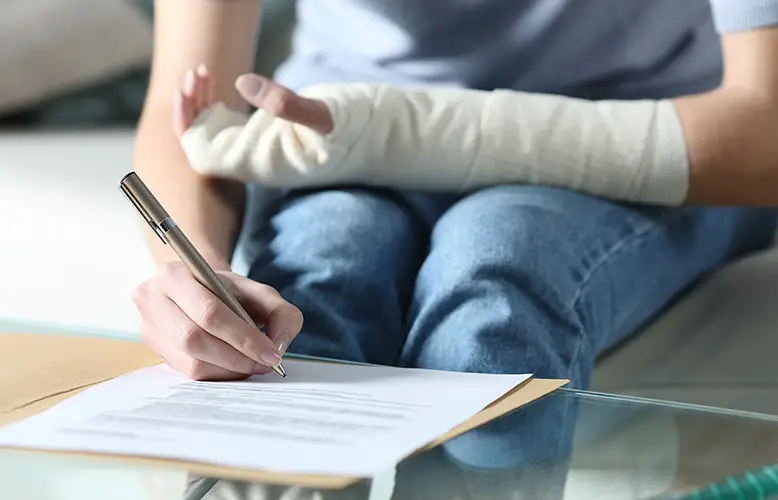When someone suffers an injury due to another party’s negligence, pursuing a personal injury claim is often the best action to seek justice and compensation. However, building a solid personal injury claim is complicated.
It requires a thorough understanding of the legal system, careful attention to detail, and a strategic approach to dealing with the complications involved.
Personal injury claims can be difficult, with various hurdles to overcome. From gathering evidence to working through legal technicalities, the process can be tough for those unfamiliar with the nature of personal injury law.

Why is a Personal Injury Claim Important?
A personal injury claim seeks to recover compensation for individuals who have suffered harm or injury due to the negligence or wrongdoing of another party.
According to the U.S. Bureau of Justice Statistics (BJS), an estimated 4 million personal injury claims are filed in state courts each year. This statistic highlights the frequency of these cases and the need for effective legal representation.
A solid personal injury claim serves as the foundation for seeking justice and obtaining fair compensation. It requires thorough evidence gathering, expert testimony, legal expertise, and strategic planning.
A 2021 study by the American Medical Association (AMA) found that the total cost of injuries in the United States is over $6 trillion annually. Personal injury claims play an important role in helping injured individuals recover some of these significant financial burdens.
Here are the key challenges when building a solid personal injury claim:
1. Establishing Liability
Establishing liability is the most important aspect of building a solid personal injury claim. A 2019 study by the American Bar Association (ABA) found that proving liability is a major challenge in over 60% of personal injury cases.
Establishing liability requires a thorough investigation, careful analysis of evidence, and a deep understanding of relevant laws and precedents. Explore ConsumerShield for more details on establishing liability and building a strong personal injury claim with expert guidance.
Through ConsumerShield, you can be connected with a seasoned attorney who can guide your legal rights throughout your personal injury case.
Here are the essential steps for establishing liability:
Gathering Sufficient Evidence
Collecting and presenting compelling evidence is the key to proving liability. This may involve obtaining witness statements, photographs or video footage of the incident, medical records, and expert testimony.
Gathering this evidence can be time-consuming and challenging, particularly if the incident occurred in a location with limited surveillance or witnesses.
Proving Negligence
In many personal injury cases, proving negligence is a major component of establishing liability. Legal professionals must demonstrate that the responsible party owed a duty of care, breached that duty, and that this breach directly caused the client’s injuries.
Proving negligence often requires a deep understanding of relevant laws and precedents, as well as a thorough investigation of the circumstances surrounding the incident.
2. Documenting the Damages
Documenting the full extent of the client’s damages is a significant component of building a solid personal injury claim. This involves accurately accounting for both economic and non-economic losses, which can be a challenging task.
Here are the key considerations for calculating economic damages:
Calculating Economic Damages
Economic damages, such as medical expenses, lost wages, and property damage, can be more straightforward to calculate.
However, legal professionals must be careful in gathering and organizing all relevant documentation, including medical bills, paychecks, and repair estimates, to ensure that no losses are overlooked.
Quantifying Non-Economic Damages
Non-economic damages, such as pain and suffering, emotional distress, and loss of enjoyment of life, can be more challenging to quantify.
Legal professionals must rely on expert testimony, detailed documentation of the client’s experience, and established legal precedents to assess the value of these intangible losses accurately.
3. Complicated Legal Procedures
Building a solid personal injury claim also involves a tough legal system with strict procedural requirements and deadlines. Legal professionals must be proficient to ensure that their client’s claim is handled correctly and efficiently.
By managing these complicated legal procedures, legal professionals can build a strong case and secure fair compensation for their clients.
Here are the key steps for complying with statutes of limitations:
Complying with Statutes of Limitations
Each jurisdiction has specific statutes of limitations that determine the timeframe within which a personal injury claim must be filed.
Missing these deadlines can result in the claim being barred, regardless of its merits. Legal professionals must be careful in assessing these deadlines and filing claims immediately.
Adhering to Court Rules and Procedures
Personal injury claims often involve various court appearances, filings, and procedural requirements.
Legal professionals must have a thorough understanding of the applicable court rules and procedures to ensure that their client’s case is handled correctly and efficiently.
4. Negotiating Fair Settlements
Negotiating fair settlements is an important aspect of personal injury cases, as it often determines the amount of compensation the client receives.
However, this process can be challenging and requires skilled legal professionals to overcome difficult negotiations with insurance companies or legal representatives.
Here are the common insurance company tactics to handle:
Overcoming Insurance Company Tactics
Insurance companies are known for employing various tactics to minimize payouts or deny claims altogether. Legal professionals must be prepared to counter these tactics, which may include lowball settlement offers, delays in processing claims, or attempts to shift blame onto the client.
Utilizing Negotiation Skills
Effective negotiation skills are essential in securing a fair settlement for the client. Legal professionals must be skilled in presenting effective arguments, anticipating counteroffers, and utilizing their knowledge of the law and relevant precedents to achieve a favorable outcome.

FAQs
Can I handle a personal injury claim on my own without legal representation?
While it is possible to handle a personal injury claim without legal representation, it is generally not recommended. Personal injury law can be complex, and legal professionals have the expertise and resources necessary to handle the challenges effectively and maximize the chances of a favorable outcome.
What happens if the responsible party refuses to negotiate a fair settlement?
If the responsible party refuses to negotiate a fair settlement, the legal professional may recommend taking the case to trial. This decision will depend on the strength of the evidence, the potential for a favorable outcome, and the client’s willingness to proceed with litigation.
How do I overcome missing or incomplete records?
Rely on alternative sources, such as witness testimony or expert analysis, and employ legal tactics to compel cooperation.
Conclusion
Building a solid personal injury claim for clients is a tough and challenging job that requires a comprehensive understanding of the legal system, careful attention to detail, and a strategic approach to dealing with the various problems that may arise.
By addressing key challenges such as establishing liability, documenting damages, managing complex legal procedures, and negotiating fair settlements, legal professionals can increase their chances of securing a favorable outcome for their clients.





